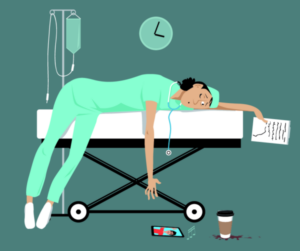 Physician burnout has become an increasingly common phenomenon in the healthcare industry. Burnout is defined as a response to chronic interpersonal stressors on the job. The three key dimensions of this response are overwhelming exhaustion, feelings of cynicism and detachment from the job, and a sense of ineffectiveness and lack of accomplishment. In a 2018 study of over 15,000 U.S. physicians, 42% reported feeling burned out. The personal effects of burnout include increased risk for cardiovascular disease, shorter life expectancy, misuse of alcohol, broken relationships, depression, and suicide. In addition to negatively affecting physicians, burnout also has a detrimental effect on patient outcomes. Physician burnout is associated with a lower quality of patient care, reduced patient satisfaction, and double the risk of involvement in patient safety incidents. Plus, when physicians leave due to burnout, finding and training replacements is costly for organizations.
Physician burnout has become an increasingly common phenomenon in the healthcare industry. Burnout is defined as a response to chronic interpersonal stressors on the job. The three key dimensions of this response are overwhelming exhaustion, feelings of cynicism and detachment from the job, and a sense of ineffectiveness and lack of accomplishment. In a 2018 study of over 15,000 U.S. physicians, 42% reported feeling burned out. The personal effects of burnout include increased risk for cardiovascular disease, shorter life expectancy, misuse of alcohol, broken relationships, depression, and suicide. In addition to negatively affecting physicians, burnout also has a detrimental effect on patient outcomes. Physician burnout is associated with a lower quality of patient care, reduced patient satisfaction, and double the risk of involvement in patient safety incidents. Plus, when physicians leave due to burnout, finding and training replacements is costly for organizations.
The American Medical Association (AMA) has compiled a list of seven warning signs that physicians can use to determine if they might be on the road to burnout:
- You have a high tolerance to stress
- Your workplace is exceptionally chaotic
- You don’t agree with your boss’ values or leadership
- You’re the emotional buffer for your patients
- Your job constantly interferes with family events
- You lack control over your work schedule and free time
- You don’t take care of yourself
Physicians spend much of their time and effort caring for others and often neglect to care for themselves. Self-care activities that physicians can use to combat burnout include exercising to reduce stress, spending time with loved ones, or taking part in other restorative activities. Talking with counselors or other mental health care professionals to address feelings of burnout is also recommended.
While healthcare organizations may feel that physician burnout is a personal issue, much of what contributes to burnout is related to a physician’s working environment. Institutions can and should address organizational-level stressors to help keep physician burnout at bay. Promoting self-care, creating a culture of collegiality and community, and allowing time for work that is personally meaningful to the physician can help. The Mayo Clinic has instituted these and other organizational strategies to promote engagement and reduce burnout. As a result of those efforts, their rate of physician burnout is one-third lower than the national average. Another resource example comes from the American Medical Association. Their free, open-platform program called STEPs Forward™ was created to help physicians and organizations improve their working environments and help prevent burnout.
Neither physicians or healthcare organizations can afford to ignore the personal, professional, and financial costs of physician burnout. Addressing the issue should be a shared responsibility; physicians cannot be expected to shoulder burnout alone, especially when organizational stressors are a significant contributor. Institution-level changes to combat the problem will have a positive effect on both the wellbeing of physicians and the bottom line. And physicians who acknowledge their own needs and invest in self-care will benefit both personally and professionally.
Jordan Search Consultants specializes in matching the right candidates with the right healthcare organizations. If you need recruitment assistance, give us a call at 866-750-7231 or email us here.


